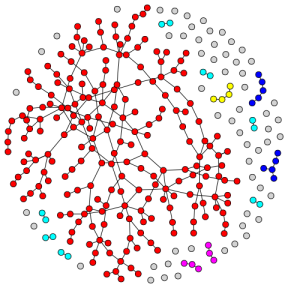Complex systems is a scientific syncretism that includes several fields dedicated to model systems that express emergent properties. Such properties includes: evolutive capacity, dynamics, robustness, long-range correlation, dissipation and chaotic behavior, among others.
Network Topology

Figure 1. Map of Königsberg in Euler’s time showing the actual layout of the seven bridges, highlighting the river Pregel and the bridges (source:Wikipedia)
Since the far decade of 1730, “The Seven Bridges of Königsberg” (Figure 1) is a notable historical problem found in mathematics that can be considered as the first approaches to the development of graph theory. The problem was to find a walk through the city that would cross each bridge once and only once. After decades of debate, Leonhard Euler in 1735, reformulated the physical problem by some abstract definition where every land is converted into a “vertex” or node, and each bridge is considered a connection or “edge” between nodes.
The asbtract formulation of Euler is considered as a graph.
In general, graphs are a collection of vertex and links. A graph may be undirected, meaning that there is no distinction between the two vertices associated with each edge, or directed, meaning that some direction is specified when connecting two vertices.
Much later on (1959), Paul Erdös and Alfred Rényi proposed some probabilistic models for generating random graphs (see Figure 2), turning these mathematical constructions into a vast research fields with many applications. However, when analyzing “real networks” such as the Internet and social networks, this model may be inappropriate. On the contrary, the models of Albert-Barabasi and Watts and Strogratz that produce “small world networks”, fits much better to the physical world.
Using the set of mathematical tools provided by graph theory and network topology, DLab members are dealing with open problems on network inference and network dynamics. To gain insights on these problems, methods based on information theory are used to infer networks from available data. Once networks are inferred, several topological parameters such as the degree of connectivity (k), clustering coefficient, topological entropy (a.k.a. robustness), different measures of centrality and the average shortest path, among others, can be used to characterize those networks.
Complex Networks in Biological Systems
Using graph theory and network topology it is possible to study complex biological networks such as those related to cellular signaling, physiological interactions and even populations.
Rule-based Modeling
Using a formal language designed to express biomolecular interactions, called Kappa, DLab members study complex dynamical systems. Also, we have developed our own software called PISKa to simulate spatial properties of system using reaction-diffussion models.


